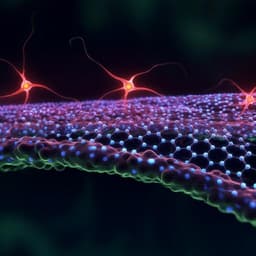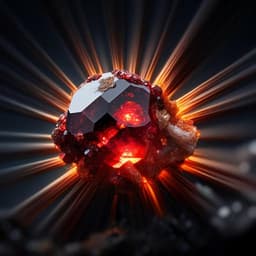
Engineering and Technology
High-Q cavity interface for color centers in thin film diamond
S. W. Ding, M. Haas, et al.
This groundbreaking research showcases one- and two-dimensional photonic crystal cavities in thin-film diamonds, achieving remarkable quality factors that set a new standard in visible photonic crystal technology. Conducted by authors from esteemed institutions, including Harvard University and the University of Chicago, this study paves the way for enhanced quantum node performance and scalability.
~3 min • Beginner • English
Introduction
Diamond hosts atom-like color centers with optically addressable, long-lived spin qubits, offering a promising platform for quantum sensing and communication. Efficient interfaces between stationary spin qubits and flying photonic qubits are essential for practical quantum networks, motivating development of high-Q, small-mode-volume photonic structures. Prior diamond nanophotonic approaches—including focused ion beam milling, Faraday-cage and RIE angled etching, and quasi-isotropic undercutting—enable photonic crystal (PhC) cavities but typically yield visible-wavelength Q factors in the low 10^4 range, far below simulated >10^5 values, likely limited by fabrication-induced roughness from complex undercutting. Thin-film diamond produced by substrate thinning or ion-slicing with regrowth can simplify fabrication, but earlier implementations suffered from thickness inhomogeneity and degraded crystal quality, limiting cavity Q to ~10^3, which is inadequate for many networking demonstrations. This work addresses the need for a thin-film diamond platform that preserves high optical quality while enabling planar, high-yield fabrication of PhC cavities to realize efficient spin–photon interfaces.
Literature Review
State-of-the-art suspended diamond PhC fabrication has relied on angled etching (Faraday cage or RIE) and quasi-isotropic undercutting. These approaches carve structures from bulk diamond, often leading to triangular cross-sections (angled etch) or long, beam-width–dependent undercuts (quasi-isotropic), and leave bottom-surface artifacts that degrade Q. Reported visible-wavelength diamond PhC cavity Qs have generally been limited to the low ~10^4 range, substantially below simulations (>10^5). Thin-film routes (ion-slicing/regrowth or substrate thinning with bonding) aimed to remove undercutting, but prior devices showed Q ~10^3 due to thickness nonuniformity and compromised material quality. Comparative records across materials: previous visible diamond PhCs around 637–744 nm reported Q ~1.4×10^4–3.0×10^4 depending on method; other low-loss visible platforms (SiN, AlN, 4H-SiC, GaP, InGaP) reported Qs up to ~1.1×10^5 (SiN at 780 nm) but not exceeding the present work. Telecom-wavelength diamond PhCs achieved up to ~2.7×10^5 via angled etching. These data underscore the need for a thin-film diamond platform achieving high visible Qs with simpler, scalable fabrication.
Methodology
Thin-film platform and materials: High-quality, homogeneous single-crystal diamond thin films (~200 × 200 µm area, 160 nm thickness) are produced by ion implantation/slicing in bulk diamond, overgrowth (regrowth), electrochemical etching, and transfer printing, then directly bonded to a SiO2/Si handle wafer. The membrane exhibits surface roughness <0.3 nm rms and thickness variation ~1 nm to minimize scattering. Silicon-vacancy (SiV) centers are created via ion implantation across the membrane prior to transfer, resulting in randomly distributed emitters with promising optical/spin properties.
Device design and fabrication: One-dimensional (1D) and two-dimensional (2D) PhC cavities operating near 737 nm are designed. 1D nanobeam cavities (lattice constant a1D = 184–226 nm, hole radius r1D = 65 nm) are formed using a quadratic hole-position shift near the waveguide center; typical simulated Q ~1.0×10^6, mode volume V ~0.5 (λ/n)^3. 2D line-defect cavities (a2D = 236–269 nm, r2D = 65 nm) are created by shifting center holes outward in a PhC waveguide; simulated Q ~7.6×10^3, V ~2.9 (λ/n)^3. For fiber/waveguide interfacing, a 1D cavity is asymmetrized by removing 9 holes on one side to critically couple to a tapered feeding waveguide (tip <60 nm); simulated Q ~1.9×10^6 for a = 255 nm.
Process flow (top-down planar): (1) Bond SiV-implanted diamond membrane to SiO2/Si substrate. (2) Pattern a Cr/Au frame by liftoff to secure the film and prevent delamination. (3) Deposit a PECVD SiN hard mask; spin-coat EB resist (ZEP520A). (4) Define PhC patterns via electron-beam lithography; transfer to SiN with SF6/H2 plasma RIE. (5) Etch diamond using O2 RIE. (6) Remove SiN and the ~1 µm oxide sacrificial layer with HF, suspending the structures. To reduce substrate coupling losses, undercut the silicon handle beneath the membrane with XeF2 to form a trench >1 µm deep. SEM confirms high-fidelity hole patterns in 1D and 2D cavities and the tapered output.
Optical characterization setups: Room-temperature off-resonant PL: excite with a 523 nm diode laser; collect scattered light via a 100× objective into a spectrometer (SpectraPro HRS-750, 1800 gr/mm grating) with a cooled Si CCD; supercontinuum source SuperK EXTREME for auxiliary measurements. High-resolution on-resonance scans: cross-polarized reflection using a tunable CW laser (M Squared, 710–790 nm) and APD (PerkinElmer SPCM-AGRH-14-FC). Input polarizer aligned to TE cavity polarization; HWP set to 23.5° to rotate incident polarization to 45°; analyzer cross-polarized to reject off-resonant light, yielding Lorentzian peaks at resonance. Waveguide-coupled devices: fiber-taper coupling (S630-HP tapered fiber) to the on-chip tapered waveguide with reflected signal detection; low pW power to mitigate thermo-optic distortions.
Low-temperature emitter–cavity studies: Confocal PL at 4 K to identify single SiVs. PLE spectroscopy and Hanbury Brown–Twiss g^(2)(τ) confirm single-photon emission. Gas condensation (N2) tuning aligns the cavity resonance with SiV ZPL transitions (A–D near 737 nm). Time-resolved PL measurements extract lifetimes on- and off-cavity resonance to quantify Purcell enhancement.
Key Findings
- Record-high visible PhC cavity Qs in diamond thin films: cross-polarized scans yield Q = 1.83 × 10^5 (1D) and Q = 1.60 × 10^5 (2D), the highest reported for visible PhC cavities in any material.
- Waveguide-coupled 1D cavity: loaded Q = (8.4 ± 0.2) × 10^4 with 95.3 ± 0.3% reflection contrast (near-critical coupling), implying intrinsic Q_i = (1.8 ± 0.4) × 10^5; cavity–waveguide coupling efficiency η_c ≈ 65%.
- Uniformity and yield: measured fundamental-mode wavelengths closely match design with standard deviations of 1.0% (7.6 nm, 1D) and 1.1% (8.2 nm, 2D). Spectrometer-limited Q > 2 × 10^4 observed in 100% (30/30) of 1D and 85% (23/27) of 2D cavities. Overall, 93% (53/57) of cavities exhibit high-Q modes with resonances near design values.
- Single-emitter metrics: Single SiV confirmed by antibunching with g^(2)(0) = 0.31 ± 0.12; PLE linewidth 605 MHz and low strain (55 GHz C–D splitting). Under cavity resonance, D-line emission shows ~20× intensity enhancement; lifetime reduced from τ_off = 1.3 ± 0.01 ns to τ_on = 0.47 ± 0.006 ns, corresponding to a Purcell factor ~13.
- Compatibility with efficient fiber extraction: tapered waveguide enables high-efficiency fiber coupling to the cavity output.
- The thin-film approach eliminates rough undercut surfaces, enabling substantially higher Q than prior bulk-etched visible diamond PhCs; 2D cavity Q improved by 20–100× over previous diamond results.
Discussion
The study demonstrates that a high-optical-quality diamond thin-film platform with planar top-down fabrication can overcome the Q limitations of bulk undercut approaches, directly addressing the need for efficient spin–photon interfaces. Achieved Q factors (up to 1.8 × 10^5 for 1D and 1.6 × 10^5 for 2D) approach simulated values more closely than prior visible diamond PhCs and enable strong enhancement of light–matter interaction, as evidenced by single-SiV Purcell enhancement (~3× lifetime reduction) and pronounced resonant intensity increase. The waveguide-coupled configuration with near-critical coupling and ~65% cavity–waveguide efficiency demonstrates practical interfacing to fibers, essential for quantum network nodes. Although experimental Qs remain about an order of magnitude below design predictions, likely due to residual absorption and scattering from lithographic and etch imperfections (hole size/position errors, surface/sidewall roughness or tilt), the platform’s uniformity and yield indicate scalability. With deterministic (masked) implantation to maximize spatial and dipole overlap, the emitter–cavity cooperativity is projected to exceed 440 (critically coupled) or 960 (undercoupled) at cryogenic temperatures, promising higher-fidelity spin control and networking performance relative to previous works.
Conclusion
This work introduces a thin-film diamond photonic platform enabling record visible-wavelength PhC cavity Qs in both 1D and 2D geometries, straightforward planar fabrication, and robust uniformity/yield. It further demonstrates practical waveguide/fiber coupling with high contrast and estimated intrinsic Q ~1.8 × 10^5, and cavity QED compatibility via coupling to a single SiV center with significant Purcell enhancement. These advances support more efficient spin–photon interfaces for quantum networking and pave the way for higher single-photon rates, improved gate fidelities, and increased on-chip functionality. Future directions include: pushing Q toward theoretical limits by reducing absorption and scattering (improved lithography and etch control); deterministic emitter placement and orientation to maximize coupling and cooperativity; integration with other photonic platforms via direct bonding; and extending the approach to other diamond nanophotonic/phononic and nonlinear devices.
Limitations
- Experimental Q values are still about an order of magnitude below theoretical predictions, attributed to surface absorption and optical scattering from fabrication imperfections (hole position/radius errors, surface and sidewall roughness, sidewall tilt).
- The demonstrated Purcell factor is limited (~13) relative to theoretical expectations due to random implantation leading to suboptimal emitter–field overlap; deterministic placement is needed to reach projected cooperativity values.
- Some measurements (e.g., cavity linewidths in spectra) are spectrometer-limited (~10 GHz), constraining direct resolution of the narrowest resonances.
- Current demonstrations are at cryogenic temperatures (4 K); performance at different temperatures or long-term stability under operational conditions is not detailed.
Related Publications
Explore these studies to deepen your understanding of the subject.







